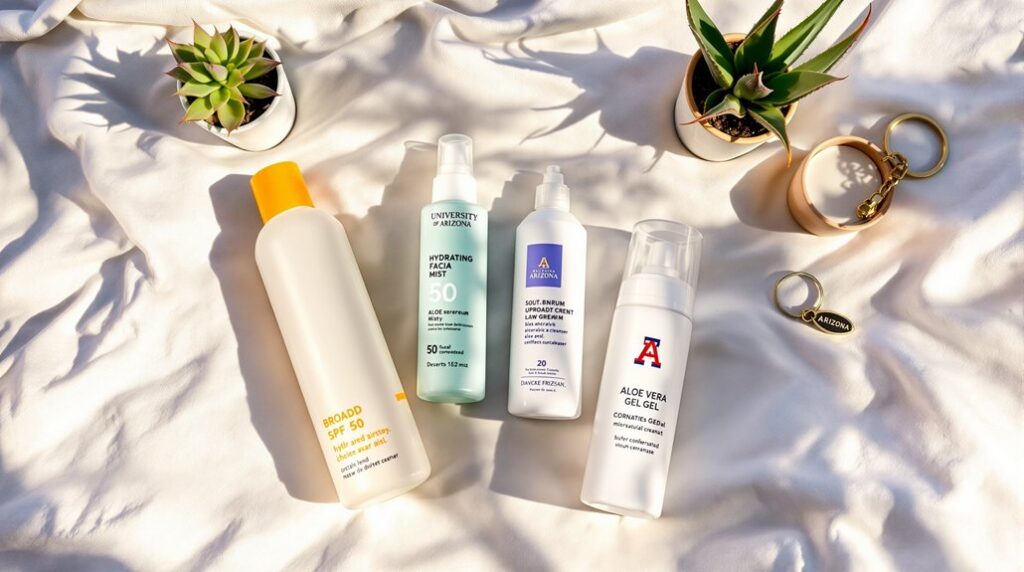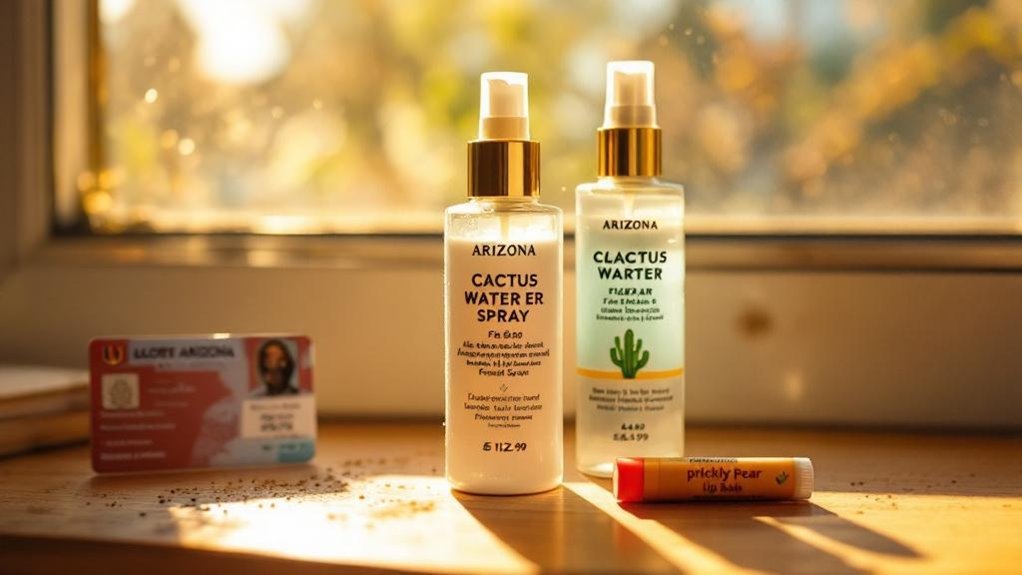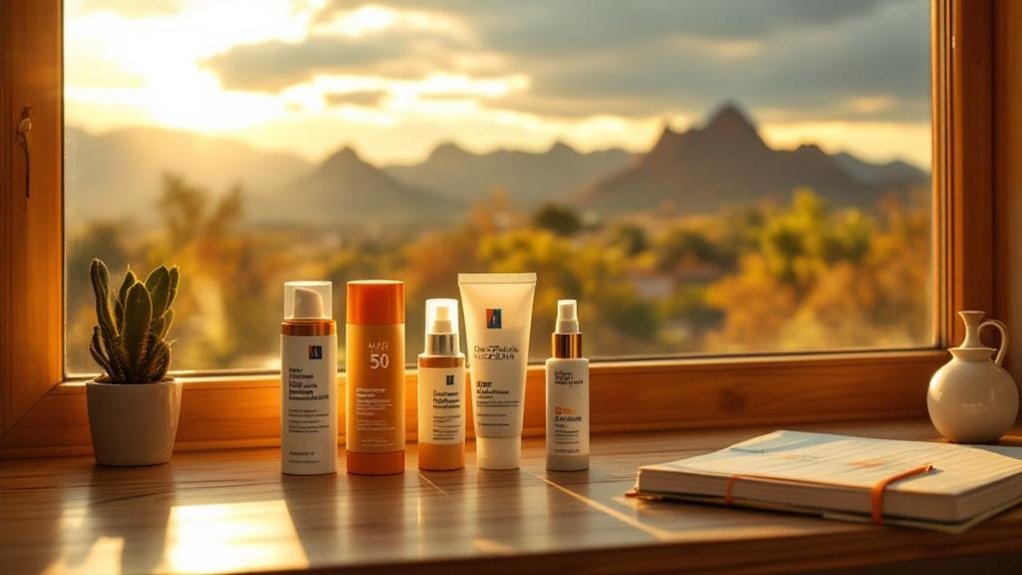Posted by: Skin And Cancer Institute in Cosmetic Procedures

College students in Tucson need specialized skincare due to the harsh desert climate. We recommend a simple morning routine with micellar water cleansing, vitamin C serum, and SPF 30+ moisturizer. Evening recovery should include ceramide-rich products and hyaluronic acid to combat dehydration. Don’t forget portable SPF for reapplication during long campus days. Seasonal adjustments between monsoon humidity and extreme dry months will greatly impact your skin’s changing needs.
Key Takeaways
- Daily SPF 50+ application is essential in Tucson’s high-UV environment, requiring reapplication every two hours during peak hours.
- Use hydrating products with hyaluronic acid and ceramides to combat Tucson’s low humidity and extreme temperature fluctuations.
- Incorporate local ingredients like prickly pear, jojoba oil, and aloe vera for affordable, effective skincare solutions.
- Adjust skincare seasonally—lighter, oil-controlling products during monsoon season and richer moisturizers during dry months.
- Maintain portable skincare essentials like micellar water and SPF wipes for quick cleansing between classes.
Understanding Tucson’s Desert Climate and Its Effects on Student Skin

Tucson’s arid desert climate poses unique challenges for college students’ skin health due to its extreme temperature fluctuations, low humidity, and intense UV radiation.
We observe that many students experience heightened transepidermal water loss, leading to dehydration, flaking, and sensitivity within weeks of arriving on campus.
Desert skincare requires adaptation to these environmental stressors. The combination of air-conditioned buildings and outdoor heat can trigger sebum overproduction or excessive dryness, depending on your skin type.
Additionally, UV exposure at Tucson’s elevation increases skin cancer risk and accelerates aging processes in unprotected skin.
Climate adaptation should become part of your daily routine. We recommend adjusting your skincare regimen seasonally, with particular attention to hydration and sun protection during the intense summer months when UV index regularly exceeds 10.
Similar to Las Vegas skincare concerns, Tucson’s desert conditions may require laser acne treatment for students experiencing severe breakouts due to the climate’s effects on sebaceous glands.
Morning Skincare Routine for Busy Class Schedules
While rushing between morning lectures and study sessions, college students often sacrifice proper skincare routines, leading to accumulated damage that’s preventable with efficient strategies.
We recommend a three-minute morning routine for Tucson students: Start with micellar water on a cotton pad to quickly cleanse without stripping natural oils—perfect when you’re running late. Follow with a vitamin C facial serum to combat oxidative stress from desert sun exposure. Finish with a broad-spectrum SPF 30+ moisturizer before heading to campus.
For those living in dorms with limited sink access, keep micellar water and pre-moistened SPF wipes on your desk. Remember, consistency matters more than complexity. Your skin faces unique challenges in Tucson’s climate, and these simple steps provide essential protection without disrupting your academic schedule. Students with ongoing skin concerns should consider consulting with board-certified dermatologists for personalized treatment plans tailored to their specific needs.
Budget-Friendly Desert Moisturizers Under $15

We recommend several wallet-friendly moisturizers that combat Tucson’s dry desert climate without exceeding $15.
Drugstore hydration heroes like CeraVe PM and Neutrogena Hydro Boost provide medical-grade hydration with ingredients such as hyaluronic acid and ceramides.
Aloe-based options including Trader Joe’s Ultra Hydrating Gel Moisturizer and Nature Republic’s Aloe Vera gel offer excellent barrier protection while soothing sun-exposed skin common among college students.
For students with specific skin conditions like acne or eczema, consulting with board-certified dermatologists can help identify the most suitable moisturizer for your unique skin needs.
Drugstore Hydration Heroes
Living in Tucson’s arid climate demands effective hydration that won’t break a student budget. We recommend several affordable drugstore options that deliver excellent results.
Cerave’s Moisturizing Cream ($12.99) contains ceramides and hyaluronic acid—natural ingredient benefits include barrier repair and deep hydration.
Neutrogena Hydro Boost ($13.49) offers gel-based hydration ideal for combination skin types.
When examining skincare ingredient labels, look for glycerin, squalane, and aloe vera, which attract and seal moisture without clogging pores.
The Ordinary’s Natural Moisturizing Factors ($7.99) delivers amino acids and fatty acids that mimic your skin’s natural moisturizing system.
Vanicream ($11.99) provides essential hydration without potential irritants like fragrances or dyes—perfect for sensitive skin steering through Tucson’s harsh environment.
Aloe-Based Budget Picks
Desert conditions demand specialized hydration, and aloe-based products offer exceptional relief for college students steering Tucson’s climate.
We recommend several evidence-based aloe formulations that deliver maximum benefit without straining your student budget.
The Ordinary’s Natural Moisturizing Factors + Aloe ($7.99) combines amino acids with soothing aloe for deep cellular hydration.
CeraVe’s Aloe Vera Gel ($10.99) integrates ceramides that reinforce your skin barrier against environmental stressors.
For sensitive skin, Trader Joe’s Aloe Gel ($6.99) offers pure aloe without fragrance or irritants.
These budget hydration options effectively combat dryness while addressing inflammation common to desert environments.
Each provides the aloe soothing properties essential for maintaining dermal integrity during long study sessions or outdoor campus activities, without compromising quality or efficacy.
Sun Protection Strategies for Campus Life
We recommend implementing a consistent daily sunscreen routine with SPF 50+ for extended outdoor campus activities in Tucson’s intense UV conditions.
Strategic planning around shade-seeking study spots, such as tree-covered quads or indoor atriums, can markedly reduce cumulative UV exposure during long study sessions.
Portable protection accessories, including wide-brimmed hats, UV-protective sunglasses, and travel-sized sunscreen for midday reapplication, should be considered essential components of every student’s backpack.
For students concerned about sun damage, consulting with board-certified dermatologists about innovative treatments like Morpheus8 can provide personalized skin care solutions that address existing damage while preventing future concerns.
Daily Sunscreen Routine
College students in Tucson face intense ultraviolet radiation year-round, making daily sunscreen application non-negotiable. We recommend integrating SPF 30+ into your morning routine, applying it 15 minutes before sun exposure.
For ideal sun protection, reapply every two hours, especially during peak UV hours (10am-4pm). Choose broad-spectrum formulations that shield against both UVA and UVB rays. Oil-free options work best for acne-prone skin, while mineral-based sunscreens suit sensitive complexions.
Don’t forget your hydration essentials—internal and external moisture supports skin barrier function. Carry a refillable water bottle and select a moisturizer with humectants like hyaluronic acid.
Many newer sunscreen formulations combine protection with hydration, making compliance easier during busy campus days.
Shade-Seeking Study Spots
Beyond applying sunscreen, strategic location choices on campus profoundly impact UV exposure. We recommend identifying shade-seeking study spots across the university grounds to minimize sun damage during your academic pursuits.
The library’s outdoor courtyard with mature mesquite trees offers excellent protection while allowing fresh air during study sessions. Consider the engineering building’s north-facing alcoves, which remain shaded throughout peak UV hours (10am-4pm).
For outdoor campus activities, the student union’s covered patio provides both social connection and UV protection. Between classes, choose walkways with architectural overhangs or tree-lined paths rather than open quads.
Remember that reflective surfaces like concrete amplify UV radiation, so even in shade-seeking study spots, maintaining your sunscreen routine remains essential for all-encompassing protection during your collegiate experience.
Portable Protection Accessories
While traversing between classes across Tucson’s sun-drenched campus, portable protection accessories become essential components of an all-encompassing UV defense strategy. We recommend investing in a compact, broad-spectrum SPF 50+ sunscreen that fits easily in backpacks or pouches for frequent reapplication.
Among accessory essentials, wide-brimmed hats provide vital shade for the face, neck, and ears—areas particularly vulnerable to UV damage. UV-protective sunglasses safeguard eyes from harmful rays while reducing squinting that contributes to premature wrinkles.
Consider portable sun umbrellas and UPF-rated clothing for additional defense. Clip-on UV sensors can alert you when radiation levels become dangerous.
These portable protection tools collectively form a comprehensive shield against Tucson’s intense solar exposure, preserving skin health throughout your academic career.
Evening Recovery Routine After Long Study Sessions
After spending hours hunched over textbooks and computer screens, your skin needs targeted recovery care to repair damage from stress and environmental factors. We recommend implementing nighttime hydration strategies with ceramide-rich moisturizers that strengthen your skin barrier while you sleep.
Incorporate skin repair techniques like gentle double cleansing to remove accumulated environmental pollutants common in the Tucson climate.
Apply a hyaluronic acid serum before moisturizer to maximize hydration absorption.
Weekly treatments with niacinamide masks can help regulate oil production—particularly beneficial during exam periods when stress hormones can trigger breakouts.
For optimal results, consider scheduling a skin condition diagnosis with board-certified dermatologists who can address your specific skin concerns with advanced technology.
These evidence-based recovery practices ensure your skin rejuvenates best overnight, leaving you refreshed for morning classes.
Dealing With Stress-Related Breakouts During Exam Weeks

Cortisol spikes during exam weeks trigger sebum overproduction, resulting in inflammatory acne lesions that require immediate attention.
We recommend using spot treatments containing benzoyl peroxide or salicylic acid for rapid intervention, while continuing to cleanse twice daily.
Implementing a preventative strategy—including stress management techniques, adequate hydration, and non-comedogenic moisturizers—can considerably reduce breakout frequency and severity during high-stress academic periods.
Students with persistent or severe acne may benefit from consulting board-certified dermatologists who can provide personalized treatment plans covered by many insurance providers, including Aetna.
Stress Hormones and Acne
During exam weeks, many college students experience a surge in stress hormones that can wreak havoc on their skin.
Cortisol, the primary stress hormone, triggers increased oil production in sebaceous glands, creating an ideal environment for acne-causing bacteria. We often see students develop inflammatory lesions when cortisol levels remain elevated for extended periods.
These stress hormones are powerful acne triggers that can undermine even the most diligent skincare routines. They also compromise your skin’s protective barrier, making it more susceptible to environmental irritants common in Tucson’s dry climate.
We recommend incorporating stress-reduction techniques into your daily routine—meditation, adequate sleep, and regular exercise can notably lower cortisol levels.
When combined with consistent cleansing and hydration, you’ll be better equipped to maintain clear skin throughout exam season.
Quick Exam-Week Remedies
When stress-related breakouts appear during exam week, swift intervention can prevent minor flare-ups from developing into persistent inflammatory conditions.
We recommend incorporating quick fix remedies into your study related skincare routine to manage these challenges effectively.
Apply ice wrapped in cloth to inflamed areas for 1-2 minutes to reduce redness and swelling.
Spot treatments containing benzoyl peroxide or salicylic acid can accelerate healing when applied at the first sign of a breakout.
Hydrocolloid patches work overnight to extract impurities while you study.
Remember that consistent hydration and proper cleansing remain essential during academic pressure.
Even during late-night study sessions, never sleep in makeup or skip your nighttime routine.
Your skin’s recovery capabilities are compromised during stress, making these protective measures particularly important for maintaining skin health during exams.
Preventative Skincare Routine
Beyond reactive measures, establishing a preventative skincare routine represents the foundation of stress-resilient skin health for college students.
We recommend starting with a gentle cleanser, alcohol-free toner, and non-comedogenic moisturizer suited to your skin type.
Contrary to anti-aging myths, sun protection isn’t just for preventing wrinkles—it’s essential for preventing cellular damage that worsens stress-induced inflammation.
Apply broad-spectrum SPF 30+ daily, even during cloudy Tucson days.
For recurring stress breakouts, consider a dermatologist consultation to identify underlying conditions like hormonal acne or rosacea.
Many students mistakenly self-diagnose, leading to ineffective treatment regimens.
We’ve found that professional guidance often reveals simpler solutions than expected.
A dermatologist can recommend specific ingredients—salicylic acid, benzoyl peroxide, or retinoids—tailored to your unique needs.
Hydration Hacks for Student Life in the Sonoran Desert

Living in the Sonoran Desert presents unique challenges for maintaining skin hydration, especially for college students maneuvering demanding schedules. At the Skin and Cancer Institute, we recommend carrying a reusable water bottle everywhere—hydration starts from within.
For desert moisture retention, we suggest investing in a portable humidifier for your dorm room. This small addition can markedly improve ambient moisture levels while you study or sleep.
Apply hyaluronic acid serums immediately after showering to lock in water before it evaporates in our arid climate.
We’ve observed that many students forget to reapply moisturizer throughout the day. Set phone reminders and keep travel-sized products in your backpack.
Our board-certified dermatologists can provide personalized skin care plans tailored to your specific needs and the unique desert environment.
Local Tucson Skincare Ingredients That Work Wonders
The desert landscape surrounding Tucson offers a surprising array of native ingredients with remarkable skincare benefits. Prickly pear extract, abundant in local ecosystems, delivers potent antioxidants that combat UV damage—essential for students walking across sun-drenched campuses.
Creosote bush, sometimes called “nature’s moisturizer,” contains compounds that reduce inflammation and balance oil production.
Several local skincare brands incorporate these indigenous elements into their formulations. We’ve observed significant efficacy in products utilizing jojoba oil, which mimics skin’s natural sebum and provides balanced hydration without clogging pores.
For those seeking the best natural remedies, mesquite pod extract offers exceptional healing properties for stress-induced breakouts.
Aloe vera, which thrives in Tucson’s climate, remains unmatched for soothing irritated skin after long study sessions or weekend adventures.
Students with persistent skin conditions may benefit from consulting board-certified dermatologists who can provide personalized treatment plans for various skin concerns.
Seasonal Adjustments for Monsoon vs. Dry Months

Tucson’s dramatic seasonal shifts between monsoon humidity and extreme dryness necessitate distinct skincare protocols for college students.
During monsoon season (July-September), increased humidity levels can exacerbate oil production and bacterial growth. We recommend oil-free, non-comedogenic formulations and incorporating salicylic acid cleansers for effective monsoon skincare.
Conversely, the dry months (October-June) demand intensive hydration strategies.
Implement dry season hydration through ceramide-rich moisturizers, hyaluronic acid serums, and overnight hydrating masks.
Transepidermal water loss accelerates markedly during these months, particularly with indoor heating systems in dormitories.
A scientific approach requires adjusting product application thickness seasonally—thinner layers during humid periods, thicker during arid conditions.
For complex skin conditions like psoriasis or eczema that worsen with seasonal changes, our board-certified dermatologists provide personalized treatment plans covered by most insurance including Blue Cross Blue Shield.
Together, we’ll navigate these environmental challenges while maintaining dermatological homeostasis throughout your academic year.
Dorm-Friendly Skincare Storage Solutions
Proper storage of dermatological products within confined dorm spaces presents a significant challenge for college students maintaining an effective skincare regimen.
We recommend utilizing vertical storage solutions to maximize limited counter space. Hanging organizers attached to doors or walls keep products accessible while preventing bathroom counter clutter.
Temperature fluctuations can destabilize active ingredients, so we advise storing sensitive formulations away from windows and heating vents. Consider clear acrylic organizers that allow visibility while maintaining order.
For shared bathrooms, waterproof labeled containers prevent cross-contamination among roommates.
Many dorm organization systems now include UV-protective components ideal for light-sensitive retinoids and antioxidants.
Remember that proper storage extends product efficacy—an important consideration when operating within a student budget.
Well-organized skincare supports consistent usage and better outcomes.
Students with complex skin conditions may benefit from seeking care from board-certified dermatologists who can provide personalized treatment plans.
Frequently Asked Questions
When Should College Students First See a Dermatologist?
We recommend college students see a dermatologist during teen years for baseline assessments. Regular screenings help establish effective teen skincare routines and guarantee proper sun protection, especially in high-UV environments.
How Do Acne Treatments Differ for Sensitive Desert-Exposed Skin?
We customize acne treatments for desert-exposed sensitive skin with gentler formulations, lower concentrations of active ingredients, and increased hydration. Natural remedies and specialized moisturizers help maintain your skin’s protective barrier in Tucson’s arid climate.
Can Skin Conditions Worsen With Poor Dorm Air Quality?
Yes, poor dorm air quality can exacerbate various skin conditions. We’ve observed pollutants, allergens, and low humidity in dorms markedly increase skin condition risks, especially for those with existing sensitivities.
Are Prescription Retinoids Necessary for College-Age Skin?
Prescription retinoids aren’t always necessary. We recommend starting with over-the-counter options like adapalene or retinoid alternatives such as niacinamide, which can effectively address common college-age skin concerns.
How Soon Should Students Address Unusual Moles or Skin Changes?
We recommend students address unusual moles or skin changes immediately. Early mole monitoring can detect serious conditions before they progress, and skin change awareness is essential for ideal treatment outcomes.
Conclusion
We’ve outlined essential skincare practices tailored to Tucson’s unique climate challenges faced by college students. Consistent application of these evidence-based recommendations will markedly reduce UV damage, prevent moisture loss, and maintain dermal barrier function despite academic stressors. By implementing these clinically-supported routines and budget-conscious product selections, you’ll establish protective habits that extend beyond your college years, preserving your skin’s long-term health in this demanding desert environment.